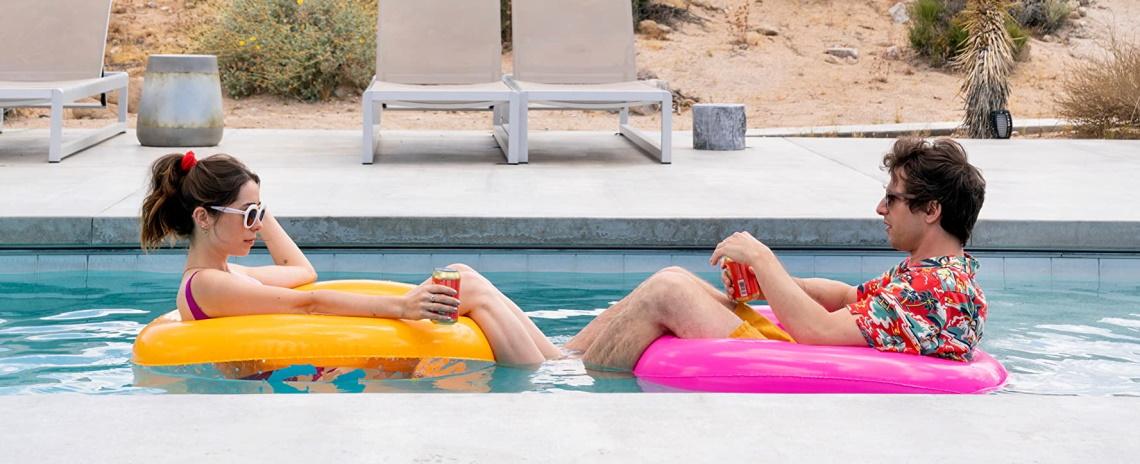If you come for Groundhog Day, you better hope you don’t miss. It’s a lesson quite a few films have had to learn in recent years. Given the unique premise and cult-classic status of Harold Ramis’ 1993 feature, one would think that today’s filmmakers would know to leave well enough alone. This is far from the case, however. Time-loop movies have resurfaced again and again across multiple genres for the last decade or so, from sci-fi Groundhog Days like Source Code (2011) and Edge of Tomorrow (2014) to horror Groundhog Days like Happy Death Day (2017) and The Endless (2017). The latest example is Palm Springs, a time-loop romantic comedy that dares to be different by playing things much closer to the original framework of Groundhog Day than other films have attempted.
To its credit, Palm Springs opens roughly where Groundhog Day’s midpoint lies, cutting out a chunk of the exposition for a premise audiences have seen many times before. Nyles (Andy Samberg), a cynic who is unfortunately trapped in a time loop, gives a drunken speech at his girlfriend’s best friend’s wedding before making his way across the dance floor and over to the bride’s sister, Sarah (Cristin Milioti). She, like everyone else in attendance at the otherwise serene Palm Springs wedding, wants nothing to do with this obvious train wreck. However, Nyles indulges in an obligatory time-loop trope and shows Sarah that he knows exactly what’s going to happen before it actually happens. She thereafter seems to show a bit more interest and follows him out into the desert for some time alone. It’s here that Nyles is unexpectedly shot in the shoulder with an arrow. A man named Roy (J.K. Simmons) is apparently responsible, given how fiercely Nyles curses his name.
Nyles crawls into the safety of a menacing-looking cave illuminated by a glowing, pulsating red light. He begs Sarah not to follow him, then gets sucked inside a portal. Naturally, Sarah follows anyway. The two find themselves back in their respective rooms at the Palm Springs resort the morning of the wedding — a commonplace occurrence for Nyles, but a horrific and disorienting one for Sarah. She demands answers, but Nyles obviously doesn’t have them. (If he did, he presumably wouldn’t be forced to repeat the same day in the first place.) Now seemingly stuck in this vicious cycle with each other (and Roy, as it happens) for the rest of eternity, the addition of a new person begins to challenge both Nyles’ loop-induced nihilism and Sarah’s diffidence. As he begins to let his guard down and accept that maybe life does have importance, she starts to trade her usefulness for a more pessimistic outlook on existence.
Despite the overtly silly humor and the refreshingly scientific approach that screenwriter Andy Siara brings to the time-loop table, Palm Springs is simply much too slight to bear any real weight. For a while, the film coasts on the relatively convincing dynamic between Samberg and Miliot. It gets plenty of mileage out of the notion that although these two aren’t as compatible as they thought they were, they are nonetheless grateful to have each other to mitigate the loneliness of their cyclical hell. Once the film takes an abrupt turn toward romantic comedy, the shift feels unwarranted (even if it is inevitable). The viewer is convinced that they’re not a great match through various gags and montages, but the same effort isn’t put into their developing attraction to one another — the audience is just supposed to roll with it. A little more time spent on these characters and their budding relationship would have gone a long way, and at only 90 minutes, Siara could’ve afforded to add some extra flesh here and there.
Notwithstanding the occasional structural flaws and weak characterization, Palm Springs ends up being sweeter and funnier than it has any right to be, simply because of its devoted cast. In addition to the strong turns from Milioti — a Broadway actress who remains somewhat unproven on film — and the always-great Samberg, director Max Barbakow elicits solid performances from J.K. Simmons and Dale Dickey in supporting roles. (I would be remiss not to mention a handful of exceptionally deranged appearances from Conner O’Malley, one of the funniest comedians currently working, as an unstable groomsman who “never should’ve left the Great Lakes.”) If anything, the film’s very bizarre, very contemporary humor is what most differentiates Palm Springs from other time-loop features. It’s absurd, yes, but that absurdity leaves a stronger impression than anything about the story itself.
The film is at its absolute best when it’s at its absolute goofiest. All the time-loop hijinks help to prevent Palm Springs from feeling repetitive — even if the film is ultimately more reductive than resonant. Unsurprisingly, repetition is an all-too-easy trap for films in this subgenre to blunder into, but Barbakow and cinematographer Quyen Tran do a commendable job mixing up the shots and the feel of each reset to help stave off monotony. (However, like many other modern releases relegated to streaming services, they are guilty of giving Palm Springs a distracting digital flair. When was it decided that comedies weren’t allowed to look good anymore?). In spite of its problems, audiences are likely to identify with a story about people who struggle to find meaning when each new day is the same as the one before — a phenomenon many are still experiencing as they continue to shelter in place as a result of the Covid-19 pandemic. The writer obviously didn’t envision this subtext when the script was first written, but the film sure does benefit from it now. Being trapped in a pre-coronavirus Palm Springs doesn’t sound too bad these days.
Rating: B-
Palm Springs is now available to stream from Hulu.


